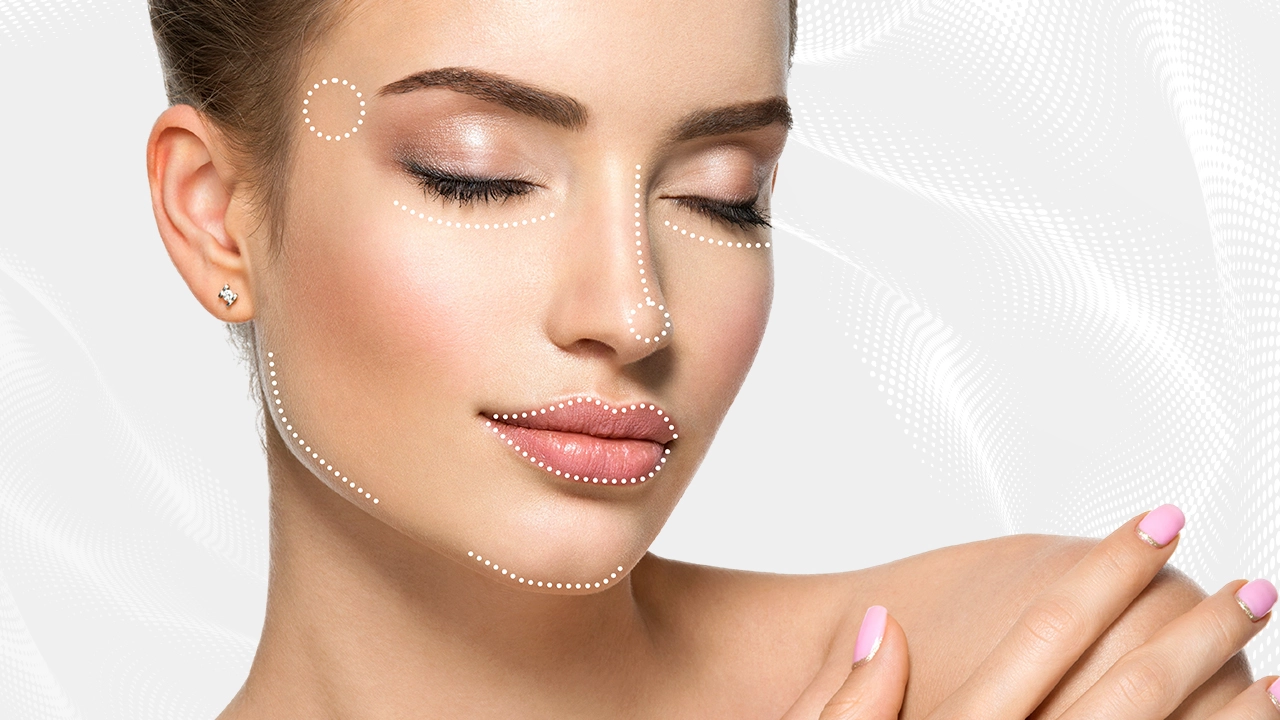
Flattened cheeks can emerge with aging or may be structurally present in some individuals. In an aesthetic face, cheekbones are prominent, and the cheek area is voluminous, contributing to a V-shaped face, which makes a person appear younger and more dynamic.
With aging, losses occur simultaneously in the skin, subcutaneous tissue, fat pads, and bone structure of our faces. Among the areas where the resulting depressions are most noticeable are the cheeks. The cheeks are like the roof of our faces, covering a large part of it. When volume loss begins in the cheeks, the face sags downwards, and the line extending from the sides of the nose to the corners of the mouth deepens even more.
The mid-cheek area also supports the under-eye area, so volume loss in this area causes deepening of the under-eye hollows. As a result of all these changes in the cheek area, a person starts to appear older and more tired than they actually are.
After cheek filling with hyaluronic acid or mineral-based fillers, the person achieves a younger and more dynamic appearance in a very short period.
Why is Cheek Filling Done?
It is done to accentuate the cheek and cheekbone area of the face. With fillers applied to these areas, the depressions in the cheeks are eliminated, or the structurally flat cheek area is made more prominent, resulting in a more aesthetic appearance. With this procedure, it is possible to get rid of the tired and aged expression and achieve the V-shape characteristic of a younger and dynamic face.
Additionally, filling done in the mid-cheek area supports and reduces under-eye hollows.
How is Cheek Filling Done?
Before cheek filling, the areas to be treated are numbed with a local anesthetic cream. Then, depending on preference, fillers containing hyaluronic acid or mineral-based fillers are placed into the necessary points using a needle or blunt-tipped cannula. The increase in volume after the procedure, which lasts approximately 15-20 minutes, is immediately noticeable.
Does Cheek Filling Enlarge the Face?
Cheek filling is an application performed on the bone and deep layers of the skin. When excessive amounts of fillers are used by inexperienced individuals, the face may widen forwards and sideways. As a result, the artificial appearance obtained is not desirable aesthetically. However, when performed by expert physicians using correct techniques, as in all filler applications, extremely natural results are achieved. The face lifts upwards without enlarging, resulting in a younger and more dynamic expression.
How Long Does Cheek Filling Last?
The duration of cheek filling varies from person to person and depending on the characteristics of the filler used, but it is generally between 9 months to 1 year.
How Much Filler is Used?
The amount of filler used varies according to the need and the characteristics of the filler. Fillers with high water retention capacity and lifting power can achieve better results with less filler. The more volume loss there is in the cheeks, the greater the need.
Possible Side Effects after Cheek Filling?
Since hyaluronic acid-based fillers and mineral-based fillers are compatible with the body, serious side effects are not expected. Like with any injection procedure, redness, swelling, and small bruises due to bleeding may occur in the injection areas. These are natural and expected side effects. All of these effects usually subside spontaneously within a few days.
Precautions Before the Filling Procedure?
Approximately 1 week before the procedure, aspirin-like blood thinners should be discontinued, and supplements such as vitamin E and green tea that increase the risk of bleeding should be avoided.
All painkillers and alcohol consumption should be stopped 2 days before.
If there is a herpes or similar skin infection in the application area or its surroundings, it must be treated, and the treatment should be completed before the procedure.
If possible, no makeup should be applied when coming to the appointment, and the face should be clean.
Precautions After the Filling Procedure?
Massaging and rubbing the treated area are not recommended.
For the first three days after the procedure, especially if there is swelling and bruising, exposure to heat such as hot baths, hammam, sauna, solarium, or sunbathing should be avoided.
Avoid blood-thinning medications and foods with blood-thinning effects for about a day after the procedure.
Alcohol should not be consumed on the same day.
Heavy sports should not be done for the first few days after the procedure.
On the same day, due to the risk of infection, the treated area should not be exposed to water, no product should be applied, and no makeup should be done.
Avoid swimming pools for 2 days due to the risk of infection.
Do not lie face down for 4 hours.
No skincare should be done on the same day. If skincare is to be done, skincare should be done first, and then the filling procedure should be performed. If it hasn't been done, skincare can be done at least 1 week after the filling procedure.
Each skin is unique to the individual. Therefore, providing the healthcare solutions and medical support that the person needs with a treatment approach tailored to them is very important. Dr. Pınar Koç specializes in dermatological disorders as well as aesthetic and cosmetic dermatology, laser applications in dermatology, and hair diseases. You can contact us for detailed information and consultancy.



